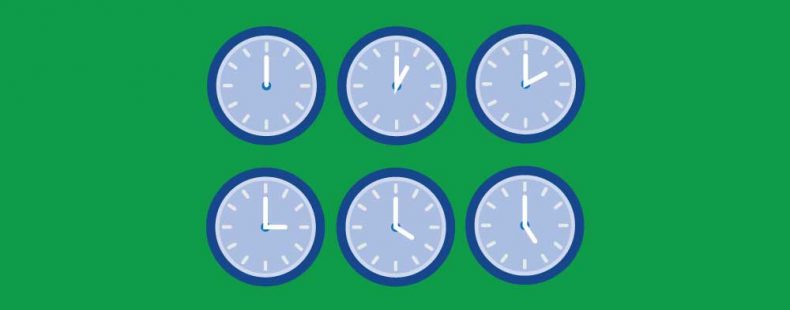No one truly needs a watch these days. We all have clocks in our pockets—our smartphones. Another benefit of this technology? The clock on our smartphone automatically changes when we enter a new time zone. Amazing!
But, even though we don’t need to pay as much attention to time zones these days, that doesn’t mean they don’t still impact our lives.
Let’s synchronize our watches and cover some of the key lingo related to time zones.
First of all, what is a time zone?
A time zone is a geographic area, typically 15⁰ longitude wide, that shares the same standard time. Standard refers to the fact that it is the official time in that area.
Time zones were first established in the UK and elsewhere in the mid-1800s, largely in response to new communication methods such as the telegraph, and new steam engines on trains and boats that accelerated travel.
Within a time zone, everyone has the same time. But how were these time zones decided upon?
Who declared Greenwich Mean Time (GMT)?
To understand how we ended up with the time zones we are familiar with today, we need to go all the way back to 1675. That’s when the Royal Observatory in Greenwich (pronounced [ grin-ij ]) was commissioned by King Charles II for the purpose of studying cartography, geography, meteorology, and related subjects (including time).
In 1721, the Royal Observatory began to use Greenwich as the location for the UK’s prime meridian in map making and navigation systems. The prime meridian is the longitude (line stretching north to south) that is considered the anchor or central point of a map, labeled 0⁰.
Fast forward to the 1800s. The UK was in need of a standard time to keep the trains running on schedule. Up until then, towns and regions were able to set their own time as they saw fit. It was decided that the mean time—in other words, the time after correcting for changes in the apparent lengths of days caused by the Earth’s rotation around the sun—in Greenwich at the prime meridian was going to be the standard. The first public declaration of Greenwich Mean Time, or GMT, was made in 1833.
In 1884, the International Meridian Conference agreed that GMT was going to be the benchmark for all time zones around the world. The name for England’s time zone is GMT+0. In France, 15⁰ degrees east across the channel, it is GMT+1, indicating that the standard time in France is one hour ahead of the standard time in England. And so on, so that there are in total 24 potential time zones around the world … although some places, like China, set their own rules.
What is Coordinated Universal Time (UTC)?
For complicated reasons that have to do with the rotation of the Earth and advancements in measurements in time, scientists in the 1960s introduced a more sophisticated and precise time standard known as Coordinated Universal Time. It is coordinated and universal because it is used around the world.
You might be wondering why the acronym for Coordinated Universal Time is UTC and not CUT. Well, that’s because in order to get the French on board with the system, it was decided the name would be given in French and English. (Typique.) Coordinated Universal Time in French is universel temps coordonné or, in other words, UTC.
Unless you’re navigating a boat or conducting scientific research, the differences between GMT and UTC would be imperceptible to you. Essentially, UTC+0 is the same as GMT+0.
Making sense of American time zones
Everything in America is a little different, including our time zone lingo. Americans don’t use the GMT or UTC format for labeling time zones. Instead, they use a homemade alphabet soup of acronyms.
In 1883, America adopted four time zones to be used by railways (and therefore everyone else):
Eastern Standard Time (EST or ET)
In the United States, Eastern Standard Time, or UTC-5, stretches from the East Coast to western Indiana. Fun fact: there is also an Australian Eastern Standard Time, at UTC+10.
America’s time zone is colloquially known as Eastern Time. Eastern Time or ET is the catch-all term for Eastern Standard Time and Eastern Daylight Saving Time (which we will get to a minute).
Central Standard Time (CST or CT)
Central Standard Time, or UTC-6, is the time zone that goes from central Kentucky to west Texas. This is generally referred to as Central Time, which is the general term for both CST and the same time zone during daylight saving time.
Mountain Standard Time (MST or MT)
Mountain Standard Time, or UTC-7, is used from central South Dakota to western Idaho. Just like the other time zones, this time zone is often referred to as Mountain Time.
Pacific Standard Time (PST or PT)
Pacific Standard Time, or UTC-8, is the standard time from eastern Nevada to the west coast. Typically, this is known as Pacific Time, whether or not it is daylight saving time.
If you watch any television, you’re probably familiar with promotions for upcoming shows that say something like “at 10/9 Central.” This means that the show will be on at 10 ET and 9 CT.
When is daylight saving time (DST)?
Spring forward, fall back. That’s the classic way to remember when it is daylight saving time.
In the fall, at the beginning of November, the time zones in the United States are all shifted back an hour. So, ET goes from UTC-5 to UTC-6. In the spring, at the beginning of March, the time zones are all shifted an hour forward. So, ET goes back to UTC-5. During that period between November and March, the time zones’ names change slightly to reflect it. For example, Eastern Standard Time becomes Eastern Daylight Time (EDT).
This somewhat maddening time-changing system has always sparked controversy. First proposed in 1905 in the UK, and first adopted in Port Arthur, Ontario in 1908, the idea behind daylight saving time is to make more use of the limited daylight hours in the winter by moving the clocks in order to encourage people to wake up earlier. In this sense, you’re saving daylight.
In the century since the idea was first floated, countries have adopted daylight saving time in different ways. Some do not observe it at all, like Afghanistan and Thailand. This can create funny differences in time zones. For example, the European Union “falls back” at the end of October, not the beginning of November, creating an additional hour of time difference between European countries and the United States for one week.
What is military time?
Twenty-four-hour clocks, or what’s known in the United States as military time, is a good way to help keep all of these time zones straight.
Instead of using the 12-hour clock that you are likely familiar with (think a.m. and p.m.), the 24-hour clock counts every hour, 1–24. For example, 3 p.m. is 15:00 on a 24-hour clock. This system avoids the confusion that the a.m./p.m. system entails (where 3:00 can refer both to 3 p.m. or 3 a.m). The 24-hour clock was adopted at the International Meridian Conference in 1884, the same one that designated the original time zones based on GMT.
In the United States, the 24-hour clock never really took off as a cultural phenomenon. However, the military quickly adopted it for use in navigation and logistics. This is how the 24-hour clock became known as military time in the United States.
Military time has a slightly different vernacular and standard than the one used by civilians. Midnight is 0000, or zero-zero-zero-zero hours. And that means 3 a.m. is written 0300, or zero-three-hundred hours, while 3 p.m. is 1500, or fifteen-hundred hours.
And if it’s so early in the morning that it is practically still dark, it is zero dark thirty. (OK, that’s not an official military time, but it is an expression used in the armed forces.)












